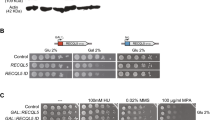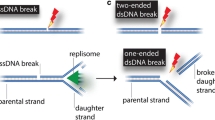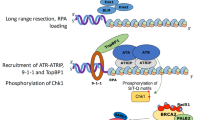Abstract
The American Cancer Society’s 2009 statistics estimate that 1 out of every 4 deaths is cancer related. Genomic instability is a common feature of cancerous states, and an increase in genomic instability is the diagnostic feature of Bloom Syndrome. Bloom Syndrome, a rare disorder characterized by a predisposition to cancer, is caused by mutations of the BLM gene. This study focuses on the partnerships of BLM protein to RAD51, a Homologous Recombination repair protein essential for survival. A systematic set of BLM deletion fragments were generated to refine the protein binding domains of BLM to RAD51 and determine interacting regions of BLM and ssDNA. Results show that RAD51 and ssDNA interact in overlapping regions; BLM100–214 and BLM1317–1367. The overlapping nature of these regions suggests a preferential binding for one partner that could function to regulate homologous recombination and therefore helps to clarify the role of BLM in maintaining genomic stability.




Similar content being viewed by others
Abbreviations
- HR:
-
Homologous recombination
- DSB:
-
DNA double-strand breaks
- SDSA:
-
Synthesis-dependent strand annealing
- BIR:
-
Break induced replication
- DHJ:
-
Double holliday junction
- BS:
-
Bloom syndrome
- SCE:
-
Sister chromatid exchange
References
Agarwal S, Tafel AA, Kanaar R (2006) DNA double-strand break repair and chromosome translocations. DNA Repair (Amst) 5:1075–1081
Bachrati CZ, Hickson ID (2003) RecQ helicases: suppressors of tumorigenesis and premature aging. Biochem J 374:577–606
Branzei D, Foiani M (2007) RecQ helicases queuing with Srs2 to disrupt Rad51 filaments and suppress recombination. Genes Dev 21:3019–3026
Bugreev DV, Yu X, Egelman EH, Mazin AV (2007) Novel pro- and anti-recombination activities of the Bloom’s syndrome helicase. Genes Dev 21:3085–3094
Chen CF, Brill SJ (2010) An essential DNA strand-exchange activity is conserved in the divergent N-termini of BLM orthologs. EMBO J 29:1713–1725
Cheok CF, Bachrati CZ, Chan KL, Ralf C, Wu L, Hickson ID (2005) Roles of the Bloom’s syndrome helicase in the maintenance of genome stability. Biochem Soc Trans 33:1456–1459
Davalos AR, Campisi J (2003) Bloom syndrome cells undergo p53-dependent apoptosis and delayed assembly of BRCA1 and NBS1 repair complexes at stalled replication forks. J Cell Biol 162:1197–1209
Davalos AR, Kaminker P, Hansen RK, Campisi J (2004) ATR and ATM-dependent movement of BLM helicase during replication stress ensures optimal ATM activation and 53BP1 focus formation. Cell Cycle 3:1579–1586
Helleday T, Lo J, van Gent DC, Engelward BP (2007) DNA double-strand break repair: from mechanistic understanding to cancer treatment. DNA Repair (Amst) 6:923–935
Hoeijmakers JH (2001) Genome maintenance mechanisms for preventing cancer. Nature 411:366–374
Hoeijmakers JH (2009) DNA damage, aging, and cancer. N Engl J Med 361:1475–1485
Langland G, Kordich J, Creaney J, Goss KH, Lillard-Wetherell K, Bebenek K, Kunkel TA, Groden J (2001) The Bloom’s syndrome protein (BLM) interacts with MLH1 but is not required for DNA mismatch repair. J Biol Chem 276:30031–30035
Li X, Heyer WD (2008) Homologous recombination in DNA repair and DNA damage tolerance. Cell Res 18:99–113
Mankouri HW, Hickson ID (2007) The RecQ helicase-topoisomerase III-Rmi1 complex: a DNA structure-specific ‘dissolvasome’? Trends Biochem Sci 32:538–546
Mao FJ, Sidorova JM, Lauper JM, Emond MJ, Monnat RJ (2010) The human WRN and BLM RecQ helicases differentially regulate cell proliferation and survival after chemotherapeutic DNA damage. Cancer Res 70:6548–6555
Nakayama H (2002) RecQ family helicases: roles as tumor suppressor proteins. Oncogene 21:9008–9021
Pedrazzi G, Perrera C, Blaser H, Kuster P, Marra G, Davies SL, Ryu GH, Freire R, Hiskson ID, Jiricny J, Stagljar I (2001) Direct association of Bloom’s syndrome gene product with the human mismatch repair protein MLH1. Nucleic Acids Res 29:4378–4386
Sharma S, Sommers JA, Wu L, Bohr VA, Hickson ID, Brosh RM, Jr (2004) Stimulation of flap endonuclease-1 by the Bloom’s syndrome protein. J Biol Chem 279:9847–9856
Sung P, Klein H (2006) Mechanism of homologous recombination: mediators and helicases take on regulatory functions. Nat Rev Mol Cell Biol 7:739–750
Sung P, Krejci L, Van Komen S, Sehorn MG (2003) Rad51 recombinase and recombination mediators. J Biol Chem 278:42729–42732
Wang Y, Cortez D, Yazdi P, Neff N, Elledge SJ, Qin J (2000) BASC, a super complex of BRCA1-associated proteins involved in the recognition and repair of aberrant DNA structures. Genes Dev 14:927–939
West SC (2003) Molecular views of recombination proteins and their control. Nat Rev Mol Cell Biol 4:435–445
Whitby MC (2005) Making crossovers during meiosis. Biochem Soc Trans 33:1451–1455
Wu L, Davies SL, Levitt NC, Hickson ID (2001) Potential role for the BLM helicase in recombinational repair via a conserved interaction with RAD51. J Biol Chem 276:19375–19381
Wu L, Davies SL, North PS, Goulaouic H, Riou JF, Turley H, Gatter KC, Hickson ID (2000) The Bloom’s syndrome gene product interacts with topoisomerase III. J Biol Chem 275:9636–9644
Yodh JG, Stevens BC, Kanagaraj R, Janscak P, Ha T (2009) BLM helicase measures DNA unwound before switching strands and hRPA promotes unwinding reinitiation. EMBO J 28:405–416
Acknowledgments
The authors thank Drs. Susan A. Gerbi and Robert W. Sobol, for their helpful discussions and critical reading of this manuscript. We also thank Dr. Nathan Ellis for his kind gift of BLM cDNA. This work was supported by the RI-INBRE Grant #P20 RR16457 from National Center for Research Resources/National Institutes of Health to KHA.
Author information
Authors and Affiliations
Corresponding author
Rights and permissions
About this article
Cite this article
Bergeron, K.L., Murphy, E.L., Brown, L.W. et al. Critical Interaction Domains between Bloom Syndrome Protein and RAD51. Protein J 30, 1–8 (2011). https://doi.org/10.1007/s10930-010-9295-8
Published:
Issue Date:
DOI: https://doi.org/10.1007/s10930-010-9295-8




